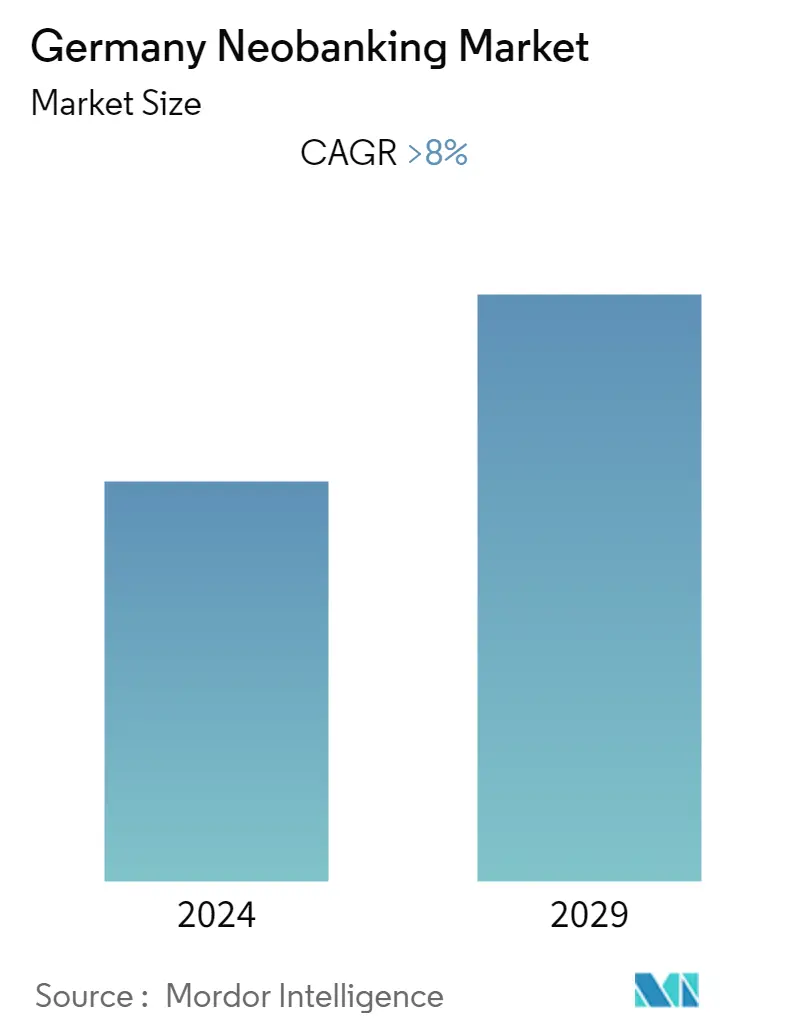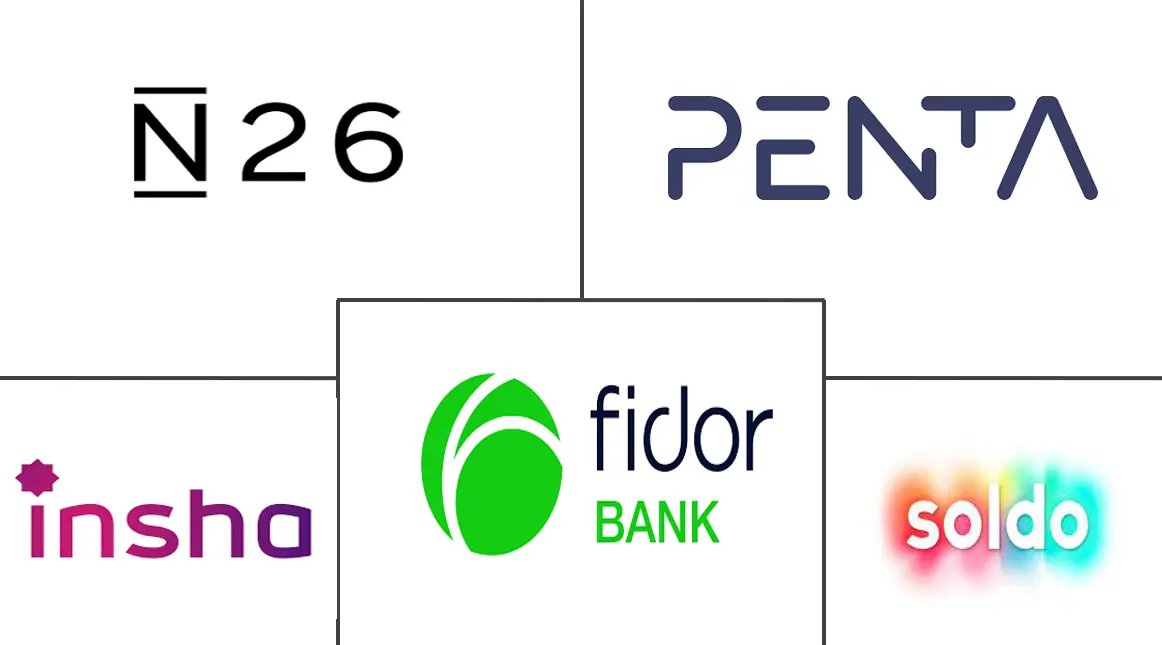Market Size of Germany Neobanking Industry

| Study Period | 2019 - 2029 |
| Base Year For Estimation | 2023 |
| Forecast Data Period | 2024 - 2029 |
| Historical Data Period | 2019 - 2022 |
| CAGR | 8.00 % |
| Market Concentration | Medium |
Major Players
*Disclaimer: Major Players sorted in no particular order |
Germany Neobanking Market Analysis
Germany's Neobanking Market is estimated to have generated USD 62 billion of transactions in 2022 and is estimated to register a CAGR of 8% for the forecast period. In the European region, German fintech is the second-largest market. Neobanking transaction value in Germany reached USD 50 billion in 2021, user penetration in Neobanking is 2.5%, and it witnessed 2 million users in 2021.
The growth of fintech in Germany didn't slow down due to the COVID-19 pandemic but boosted it. Investors pumped almost 3 times as much money into fintech based in Germany compared to 2020. The increasing adoption of mobile banking platforms and fully digital banking experience contributed significantly to the market growth. The German fintech sector broke the 900 mark for the first time with 946 start-ups. Investment start-ups showed the strongest growth of all top fintech categories.
N26 is the first Neobank founded in Germany, and it is one of the largest European fintech companies. It leverages AI to organize a user's expenses by category and make it easier to track spending. N26 takes an average of 170,000 new customers a month.
Germany Neobanking Industry Segmentation
Neobanks is a bank that operates online without having a physical presence; it is part of fintech that provides digital and mobile-first services like payments, debit cards, money transfers, lending, and more. A complete background analysis of the market, which includes emerging trends, significant changes in market dynamics, and a market overview, is covered in the report. The report also features a qualitative and quantitative assessment by analyzing data gathered from industry analysts. Germany Neobanking Market is segmented by account type (Business Account and Savings Account), by service (Mobile Banking, Payments & money transfer, Savings account, Loans, and others), and by application (Enterprise, Personal, and others). The report offers market size and forecasts for Germany Neobanking Market in value (USD Million) for all the above segments.
| By Account | |
| Business account | |
| Savings account |
| By Service | |
| Mobile Banking | |
| Payments & Money transfer | |
| Savings account | |
| Loans |
| By Application | |
| Enterprise | |
| Personal |
Germany Neobanking Market Size Summary
The neobanking market in Germany is experiencing significant growth, driven by the increasing adoption of mobile banking platforms and fully digital banking experiences. As the second-largest fintech market in Europe, Germany has seen a substantial rise in neobanking transactions, with a notable increase in user penetration. The COVID-19 pandemic acted as a catalyst for this growth, with investors significantly boosting their investments in German fintech compared to previous years. The market is characterized by a robust startup ecosystem, with a high concentration of fintech companies in cities like Berlin and Frankfurt. N26, a pioneering neobank in Germany, exemplifies the sector's innovation by leveraging artificial intelligence to enhance user experience and expense management.
The German neobanking market is also witnessing a surge in digital payment solutions, with mobile payments becoming increasingly popular. This trend is supported by the country's leading position in digital commerce users within Europe. The market is dominated by a few major players, but technological advancements and service innovations are enabling both domestic and international companies to expand their presence. Companies like N26, Fidor Bank, Bunq, Insha, and Soldo are key players in this space. Despite challenges, such as the recent bankruptcy of Rukky, the overall outlook for the neobanking market in Germany remains positive, with continued growth anticipated in the coming years.
Germany Neobanking Market Size - Table of Contents
-
1. MARKET DYNAMICS AND INSIGHTS
-
1.1 Market Overview
-
1.2 Market Drivers
-
1.3 Market Restraints
-
1.4 Insights on Various Regulatory Trends Shaping the Market
-
1.5 Insights on impact of technology in the Market
-
1.6 Industry Attractiveness - Porter's Five Forces Analysis
-
1.6.1 Threat of New Entrants
-
1.6.2 Bargaining Power of Buyers
-
1.6.3 Bargaining Power of Suppliers
-
1.6.4 Threat of Substitutes
-
1.6.5 Intensity of Competitive Rivalry
-
-
1.7 Impact of COVID-19 on the Market
-
-
2. MARKET SEGMENTATION
-
2.1 By Account
-
2.1.1 Business account
-
2.1.2 Savings account
-
-
2.2 By Service
-
2.2.1 Mobile Banking
-
2.2.2 Payments & Money transfer
-
2.2.3 Savings account
-
2.2.4 Loans
-
-
2.3 By Application
-
2.3.1 Enterprise
-
2.3.2 Personal
-
-
Germany Neobanking Market Size FAQs
What is the current Germany Neobanking Market size?
The Germany Neobanking Market is projected to register a CAGR of greater than 8% during the forecast period (2024-2029)
Who are the key players in Germany Neobanking Market?
N26, Fidor Bank, Bunq, Insha and Soldo are the major companies operating in the Germany Neobanking Market.

